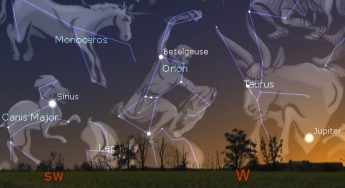This Week’s Sky at a Glance, 2024 April 20 – April 27
This Week’s Sky at a Glance, 2024 April 20 – April 27
This weekend the brightest object in the evening sky is the Moon, near its farthest at about 400,000 kilometres. The next brightest object is Jupiter, currently at 888 million kilometres and receding. Uranus, possibly visible in binoculars nearby, will be 3 billion km away. Light travels at 300,000 km per second, so at 150 million km the Sun is a distance of 500 light seconds away. The Moon is a tad more than one light second away, Jupiter is 49 light minutes, and Uranus about 170 light minutes.
The brightest star we see in the evening now is still Sirius, the closest star we can see from New Brunswick at 8.6 light years (ly). The next brightest is Arcturus and it is 37 ly or 350 trillion kilometres. Polaris, the North Star, is about 400 ly away; and Alnilam, the middle star of Orion’s belt, is 2000 light years. If you are under a dark sky well before morning twilight you might get a naked eye glimpse of the Andromeda Galaxy at a distance of 2.5 million light years. Binoculars will reveal galaxies even more distant, but at what point do these distances become incomprehensible and “way far” is a reasonable answer?
This Week in the Solar System
Saturday’s sunrise is at 6:29 and sunset will occur at 8:17, giving 13 hours, 48 minutes of daylight. Next Saturday the Sun will rise at 6:18 and set at 8:26, giving 14 hours, 8 minutes of daylight (6:18 and 8:26 in Saint John).
The Moon is near Spica in Virgo on Monday, it is full on Tuesday, and is seen near Antares in Scorpius on Friday. Saturn rises around 4:50 midweek, an hour before Mercury but just 20 minutes before Mars. Jupiter is low in the west in evening twilight and binoculars might reveal Uranus within the same binocular view to its right. The Lyrid meteor shower peaks on Monday morning, with shooting stars emanating from near the bright star Vega high in the southeast,
On Sunday evening at 8 pm, tune in to the Sunday Night Astronomy Show via the Facebook page or YouTube channel of Astronomy by the Bay.
Weekly Sky at a Glance ~by Curt Nason

